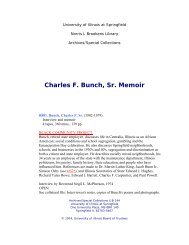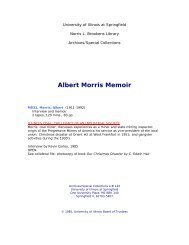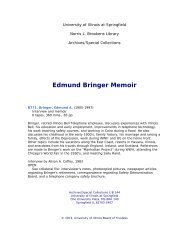Gerald W. Smith Memoir - Brookens Library
Gerald W. Smith Memoir - Brookens Library
Gerald W. Smith Memoir - Brookens Library
You also want an ePaper? Increase the reach of your titles
YUMPU automatically turns print PDFs into web optimized ePapers that Google loves.
<strong>Gerald</strong> W. <strong>Smith</strong> 216IA. I believe that these are the principal general issues that smfac dduring the period of discussion on a master plan -&Lately after itwas published in the period just prior to the beginning of the legisl -ture and when the cormnittee and the Governor and Dr. Glenny and Dr. B ownewere trying to agree on specifics to be drafted into a bill.Q. I keep thinking that this is a beautif'ul example of the nature of theprocess that a society like ours has to go through in order to arriveat any kind of consensus, a workable consensus, for doing something alongthe line of what was being proposed. Nobdy's pure wishes found fulfillment,but enough of everybody's wishes found f'ulfillmnt as the thingfinally developed that there could be a concerted agreement and consensus,let's do it, let's go ahead. That must have been a very exciting thing toparticipate in, Gerry.A. Yes, it was a lively discussion, somet~s a heated discussion (laughter)and it caught the attention of the legislature, it caught the attention ofthe press and the other news media, it caught the attention of almost everystate-wide organization that had any kind of a platform regarding the developmentof education in the State. It was a subject of a multitude ofmeetings, educational conferences, and so forth. I believe unless you havesometh- else in mind that this would be a good time now to speak directlyto the resolution of the issues.Q. Very good, Gerry. You know the story and you pmticipated in it, andthis is what we want to get. Let's shift over to the resolutions of thedlf ferences .A. Alright. Now the resolution of some of these differences appears inthe final edition of the master plan itself. Others were taken care ofduring the work of the governor's corranittee and his office just prior tothe drafting of the bill, and some of them came out as amendments to thebfll, House Bill 1710, after it was introduced, so the resolution of themoccwred in stages. The principal change that the Board of Higher Educationmde is a result of issues brought to their attention in the healpingsand had to do with the concern of the people in southern Illinois overthe standard for the size of districts. They did modim in the form inwhich it appeared in the final publication of July, 1964, and their mqdificationwas a paragmph which dealt with an additional standard. They retainedthe original stmda3-d of 30,000 population and $75,000,000 assessedevaluation. Now, interestingly enough, in spite of the fact that theyheard considerable discussion, they did not raise it. They retained mat.But they put in another one which pointed out that if the total part of 3counties not contained withh a junior college district, joined togetherto form a cormunity college distrkt, then theye were no specific standmdsas to population or assessed evaluation, and that was written into tha msterplan and subsequently into the law. Interestingly enough, no one evertried to do that, after it came into existence that did not become a problemor an issue.9. So that the 30,000 population and $75,000,000 rfhimum became the Fevailingpat tern.





